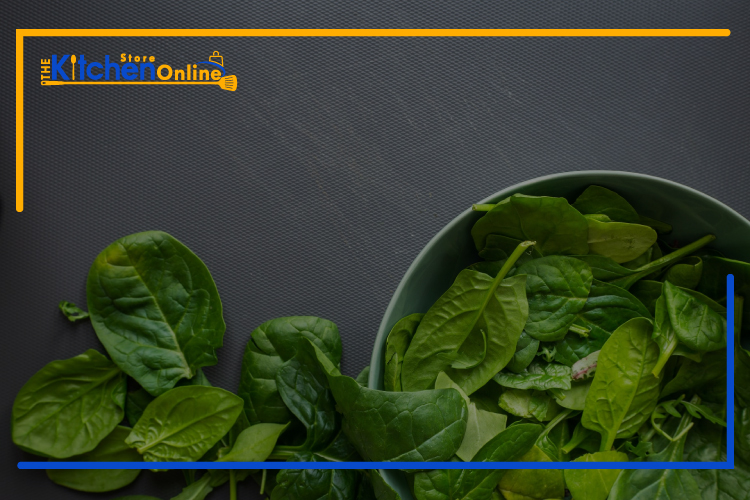Leafy greens like spinach are highly nutritious, but they can go bad fairly quickly because they are mildly flavored.
In order to keep spinach as fresh as possible, you should learn how to store spinach so that you can have it in your daily salad for the longest time.
How do you store spinach? Spinach is best stored in an airtight container or bag in the refrigerator for 7-10 days. When storing spinach, it’s best not to wash it before you use it. Alternatively, you can freeze spinach for up to three months before using it.
Here are our tips and best practices for keeping spinach fresh for up to 10 days as well as how to freeze spinach and how to store cooked spinach correctly.
Best Way to Store Spinach
Spinach is a healthy, nutritious, delicious leafy green vegetable that tends to go bad pretty quickly if you forget about it for a few days in your refrigerator.
When compared to other vegetables and fruits, why does spinach go bad so quickly? Even the smallest amount of moisture can cause spinach leaves to turn slimy and soggy very quickly.
Even a drop of water on one spinach leaf will cause the entire surrounding leaves to become damp. In fact, if you don’t watch out, this damage can spread quickly, ruining an entire batch of spinach quickly.
Luckily, we’re going to offer a few storage tips that you can use to keep your spinach as fresh and crisp as possible.
How to Tell if Spinach is Bad
Spinach that is bad is easy to detect, and there are a few gradually less pleasant signs:
- Occasionally, a leaf will be limp and slimy and darker in color than the others
- Chunks of slimy spinach leaves that appear to be melting into one another
- Your container or bag is filled with brown liquid
- Your container or bag has a very unpleasant smell
It’s possible to salvage unaffected spinach leaves if you find that your spinach is turning bad, but you should do so immediately if the spinach is still at stage 1 or 2.
It’s probably better to compost the entire batch if you see brown liquid or smell something unpleasant.
How to Wash Spinach
The print on spinach containers or bags should tell you whether it has been pre-washed. A commercial facility has special techniques for washing and drying spinach that remove all the dirt and bacteria without causing damage to the leaves.
The spinach you get is already washed, so there’s no need to wash it again if it’s sealed in a bag or container.
Fresh spinach needs to be cleaned to remove dirt, girts, and potentially harmful bacteria.
Rather than washing and storing spinach, you should wash it only before you use it. When you wash it right before consumption, there is less chance that it will go bad.
To wash spinach, follow these steps:
- Fit a colander inside a large bowl of cold water.
- Let the spinach leaves soak for just one or two minutes in the cold water in the colander.
- By lifting and swishing the leaves with your hands, allow any sand or grit to sink to the bottom and pass through the holes in your colander.
- The spinach will cook faster if it is removed from the water and shaken gently to remove as much water as possible.
- You can prepare the spinach immediately if you are cooking it.
- Fresh spinach should be spread over a clean kitchen towel and dried using another clean kitchen towel.
- In addition to using a salad spinner, you can make sure that your salad doesn’t wilt by removing as much of the leftover water as possible before serving.
How to Store Spinach in Fridge
It is best to store spinach in the refrigerator if you want to eat it fresh.
The following steps must be followed from the grocery store to the refrigerator, however, to ensure that spinach remains fresh for as long as possible:
- The container must be large enough to hold all the spinach gently, without crushing it. It should also have a lid.
- If you are going to store your spinach in a container with a bottom, line it with a dry paper towel or a clean, highly absorbent kitchen towel, such as these Swedish dishcloths – this will help prevent moisture from getting into the container.
- The spinach leaves should be very dry. Layer the towel loosely over them.
- A layer of kitchen towels or paper may also be added to a very large container if there is a great deal of spinach.
Make sure you remove any leaves that look damaged, slimy, or moist from your fresh spinach before transferring it to your storage container. It is better to lose a few leaves up front than lose your entire bunch in just a day or two due to this minor rot.
Additionally, if possible, it’s a good idea to sift through your spinach every day, looking for any damaged leaves that need to be removed.
Does Spinach Always Need to be Refrigerated?
To eat fresh spinach that same day, you can leave it at room temperature out of direct sunlight for a few hours. It will wilt faster in direct sunlight or heat.
It is advisable to wash spinach (unless it has been pre-washed) carefully after leaving it outside for some time.
Spinach that has been pre-washed can also be kept on the counter for a few hours before using. If you don’t plan on eating all of it right away, you should refrigerate the delicate green as soon as possible.
How Long Does Spinach Last?
How fresh spinach is when bought and how it was purchased will determine how long it will last.
Spinach that has been washed, dried, and carefully sealed will last longer than a fresh bundle since there is less rotting or moisture.
In a fridge, most fresh spinach will last about a week if stored carefully as described in this article. Spinach bundles don’t usually last as long, but a well-maintained container of pre-washed spinach can last up to 10 days.
How to Keep Spinach Fresh Longer
It is best to continually monitor your spinach for signs of moisture exposure and remove any damaged leaves to keep it as fresh as possible.
Remove any darkened leaves before they start getting slimy if you notice them starting to darken. They’ll be perfect for cooking.
You can keep spinach at a temperature between 32 and 36 Fahrenheit if you can adjust the temperature where it’s being stored, which is colder than most fridges.
You can keep your spinach at 40 degrees Fahrenheit, but it would be even better if you can keep it in a humidity-controlled drawer that doesn’t lose its moisture when the door is opened and closed.
How To Keep Spinach From Wilting
Keeping spinach in warm temperatures for too long will cause it to wilt, but exposing it to moisture will cause it to rot.
You should refrigerate spinach within a few hours of purchasing or harvesting it in order to prevent it from wilting. When possible, keep spinach out of direct sunlight or heat.
All leafy green vegetables thrive in a humid environment, even though moisture is the kiss of death for spinach. When there is a large airflow, the leaves can easily lose moisture, but humid air protects the leaf’s water content, preventing it from evaporating.
To avoid condensation, it is crucial to have a humid environment with little air movement.
Can You Store Spinach With Salad Dressing?
Adding salad dressing to spinach is not a good idea. Wet, fresh spinach leaves will go slimy much faster because of the moisture and acidity in the dressing.
Preparing dinner and making a spinach salad in advance means that you should separate your spinach from the rest of the ingredients until you are ready to toss them together.
It will also protect the leaves from being crushed in the last moment, as well as from added moisture from the dressing.
How To Store Bagged Spinach
In a sealed bag, pre-washed spinach can be stored in your refrigerator until it is opened.
If it gets crushed by any other items in your fridge, it will go bad, even in a sealed environment. Make sure the leaves don’t get crushed by other items in your fridge.
Make sure that the bag does not show any signs of condensation.
In either case, you will want to move the spinach to a new container, as described above in ‘How to Store Spinach in the Fridge.’ If there is any moisture in the bag or the bag has been opened, you will want to transfer it to a new container.
How To Store Fresh Picked Spinach
Taking care of your spinach begins with harvesting it properly. Instead of pulling or gathering dozens of spinach leaves at once, you should cut them individually.
If you clip each leaf separately, you will better protect the plant, allowing it to regrowth, but you will also minimize soil and dirt collected with the leaves, making it easier to clean and store.
It’s best to harvest spinach only as close to the time you’re going to serve it as possible, if you are growing it yourself. As a result, you can wash your spinach leaves immediately and serve it soon after, reducing the chances of it wilting or spoiling.
Hold off on washing spinach leaves until you’re ready to serve it, especially when your season is ending or you’re harvesting a large quantity that will require storage. In the same way, if you buy a bundle of fresh spinach leaves from your local grocery store or farmer’s market, you should eat the leaves right away.
All the same storage instructions apply, but make sure you wash the leaves thoroughly before eating them.
Best Containers to Keep Produce Fresh
There are containers that are specifically designed for storing spinach or other leafy greens most efficiently because they are so delicate.
In order for the design to work, you must have an elevated basket that allows moisture to drain into a separate well, thus maintaining humidity without damaging leaves.
The OXO GreenSaver Produce Keepers are our favorite container for keeping produce fresh, particularly spinach. A carbon filter traps ethylene gas and slows down the degradation process. They come in a variety of shapes and sizes.
Best Bags to Keep Produce Fresh
Produce like spinach can also be kept in bags that maintain freshness. Unlike other produce keepers, Debbie Meyer GreenBags have proven themselves over time as the best.
Spinach in these green bags will stay fresher for longer. They are reusable and recyclable. The bags require some care to prevent your spinach from being crushed, but they are remarkably effective in keeping spinach fresh in the fridge for about a week to ten days on average.
How To Keep Spinach Fresh Without Fridge
It may be a good idea to freeze your fresh spinach if you won’t be able to consume it before it goes bad in the fridge.
It will have a better taste and texture when you thaw frozen spinach, and the nutritional value will be preserved. The sooner you freeze your spinach, the better.
Get rid of any damaged, old, tough, or discolored leaves before freezing them. Rather than contaminate the entire batch, it is better to sort these out before freezing, so that they do not freeze well.
When you cook spinach, you know that a large amount of fresh leaves yields only a very small amount of cooked greens. Freezing spinach is the same.
For every 2 pounds of fresh spinach, you can expect to get about one quart of frozen spinach. This will depend on the type of spinach you have and how it is packaged. Storing uncooked tapioca pearls is also difficult. Visit and learn here How To Store Uncooked Tapioca Pearls?
How to Store Spinach in Freezer
You should blanch spinach first before storing it in your freezer. A vegetable can be protected from deterioration by blanching.
Blanching can be done either by boiling or steaming your leaves.
No matter how quickly or gently you boil your leaves, more nutrition and color will be lost to the water. Nevertheless, you can save the water and use it to make broth, soup, or to cook something else to regain some vitamins and minerals.
The spinach can then be compressed into silicone cubes for freezing or freezer-safe bags after you’ve squeezed out as much water as possible from it.
It is a good idea to squish as much air and water out of the spinach as possible before freezing it.
You will need to remove the spinach from the freezer cubes once they are completely frozen and transfer them to a freezer-safe bag.
You can also freeze the spinach directly in the freezer-safe bag, pressing it flat and squeezing out as much air as possible before sealing tightly.
If you use cubes, your leaves will likely be crushed and won’t keep much structure after they thaw. If you use a bag, you can lay your leaves flat, instead of crushing them together. That way, their shape will be preserved better.
How To Blanch Spinach Leaves
You can easily blanch spinach, but if you’ve never done it before, here’s how:
- You should have a large pot of boiling water as well as a large bowl of ice water ready.
- Spinach should be placed in a mesh colander.
- Make sure all leaves are fully submerged in the boiling water.
- To prevent the leaves from cooking, boil for 45 seconds and then remove the colander. Transfer to ice water immediately and let cool for 45 more seconds..
- Immediately transfer the ice water to them and let them cool for 45 seconds.
- Take the fish out of the water.
- Use a colander and your hands to squeeze out as much water as you can.
- In order to remove more moisture, transfer the salad to a salad spinner.
- The leaves should be transferred to a clean kitchen towel, in a single layer, and another kitchen towel is used to absorb any moisture left.
How To Freeze Spinach Without Blanching
It is important to blanch your spinach if you plan on freezing it for a few months, but you can skip this step if you plan on using it within just a few weeks. During such a short period, there is not likely to be enough enzyme action to cause your spinach to lose quality.
If the spinach has already been washed, you can spread out the leaves directly in a freezer-safe bag, keeping the layers as even and flat as possible. Ensure that any air is removed from the bag before sealing it.
You should wash and thoroughly dry garden-fresh spinach before freezing it.
By using a vacuum seal machine, spinach can also be frozen without blanching. Your spinach will remain protected for a longer period of time with this method. If you freeze the spinach into smaller portions, it will freeze more thoroughly and will be of better quality when it is thawed.
How To Freeze Spinach For Smoothies
You may want to puree your fresh spinach before freezing it if you plan to use it exclusively for smoothies.
With an ice cube tray or freezer tray, you can freeze the spinach and have convenient, easy-to-blend cubes of spinach whenever you want one.
You can also use this method when you’re cooking with spinach. Do not leave your frozen solid cubes exposed to freezer air for months in the ice cube tray; transfer them to a freezer-safe bag instead.
How Long Does Spinach Last in the Freezer
Fresh spinach should keep its best quality for 2–3 months when kept in an airtight container. In the following weeks, you might notice a slight change in flavor, color, and texture. Nutritional value will decline as well.
When using frozen spinach, you should use it within one year. In general, the longer frozen vegetables have been, the more likely you are to use them in soups or sauces rather than serve them alone as a side dish.
How to Store Cooked Spinach
You should always store cooked spinach in the fridge within two hours of cooking. Avoid opening the container until you’re ready to eat and use an airtight container with an airtight seal.
Cooked spinach should be consumed within three days.
How to Tell if Cooked Spinach is Bad
It’s more difficult to tell if cooked spinach has gone bad since it’s naturally slimy.
Discard any item that displays discoloration, spots, or unpleasant odors. You shouldn’t eat cooked spinach that isn’t sure about because it can become ill if it has gone bad.
Reheating Cooked Spinach
Spinach can be reheated quickly and easily.
In the microwave, we prefer short bursts of 30 seconds. If you would like more details on how to reheat spinach, as well as whether or not it is safe to do so, check out our related article, Reheating Spinach – Is It Safe? Find out in the next section!





